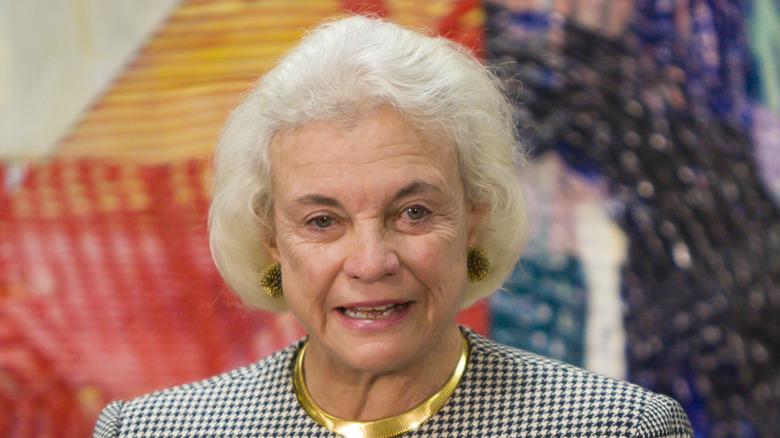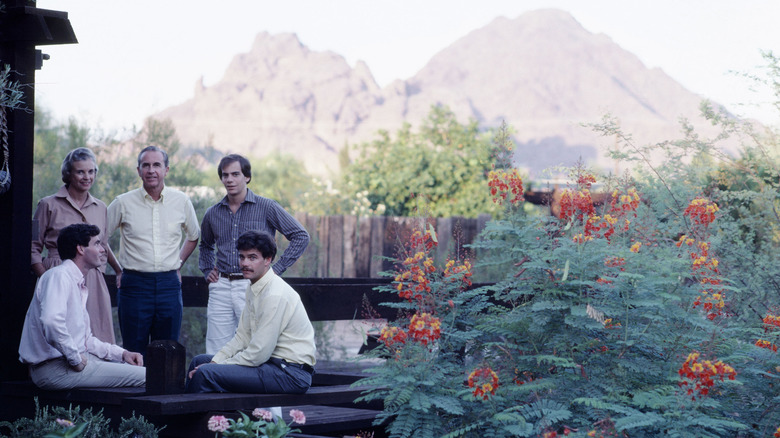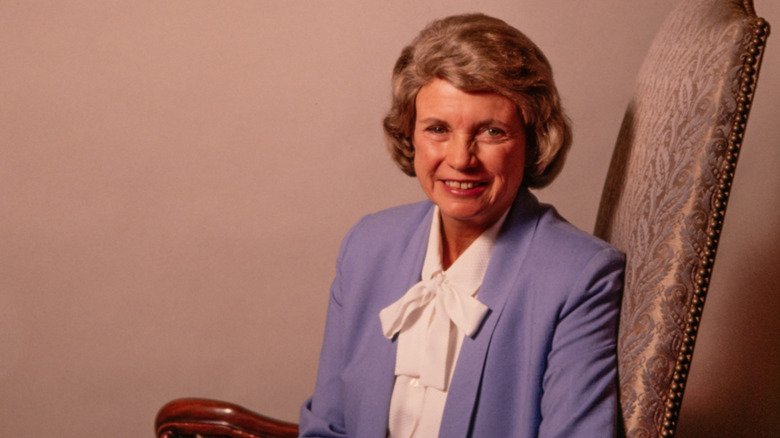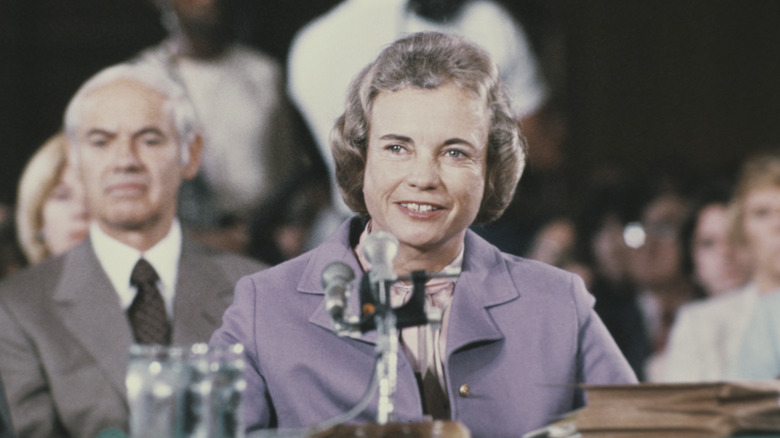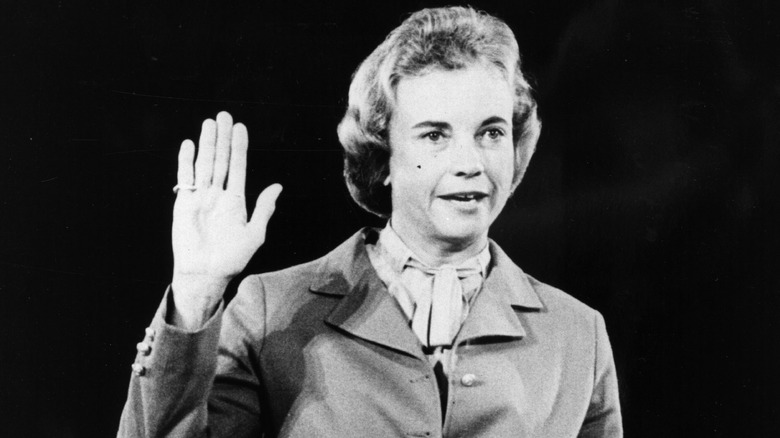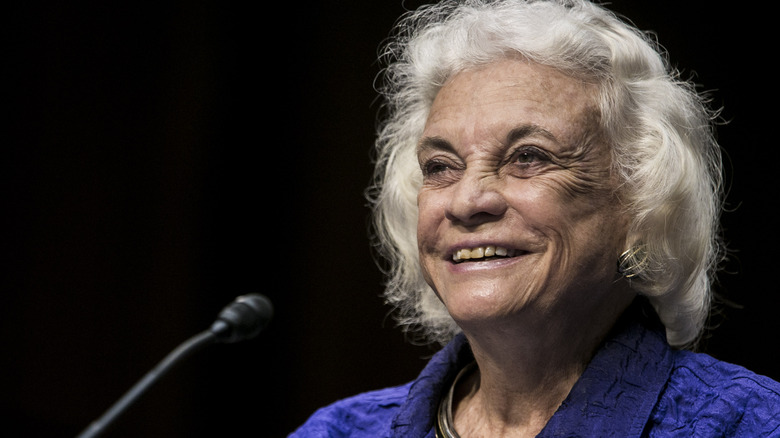Sandra Day O'Connor, First Female Supreme Court Justice, Dead At 93
Sandra Day O'Connor, who served as the first woman to ever sit on the Supreme Court, died at age 93 on December 1, per NBC News. A statement from the court confirmed O'Connor's death was due to advanced dementia, and came after a respiratory illness.
O'Connor paved the way for other women to join the Supreme Court, including Ruth Bader Ginsberg, who was the second woman to become a justice (via PBS). O'Connor and Ginsberg sat on opposite sides of the aisle, but they rallied together to support one another regardless of political party. Though O'Connor was a conservative, she often voted in alignment with more liberal judges. Upon her retirement in 2005, many were afraid a new justice would be appointed who would overturn Roe v. Wade (via History).
"We at the Supreme Court mourn the loss of a beloved colleague, a fiercely independent defender of the rule of law, and an eloquent advocate for civics education," Chief Justice John Roberts said in SCOTUS' statement announcing O'Connor's death. "And we celebrate her enduring legacy as a true public servant and patriot." O'Connor is survived by three sons, and leaves a lasting legacy as a history-making judge.
Sandra Day O'Connor attributed her work ethic to growing up on a cattle farm
Before Sandra Day O'Connor made political history, she lived a simple life. According to the O'Connor Institute, she was born in Texas in 1930 but grew up on a cattle ranch in Arizona. Lovingly called the Lazy B, the ranch was the most successful and largest operation in Arizona at the time. It was run by her parents Harry and Mae Day.
O'Connor gave credit to her time on the ranch for teaching her the values that would lead to success later in life. "It doesn't surprise me that she took this professional experience as a ranch cowgirl out here in the country and was able to make it work in a different environment," her son, Brian O'Connor, told AZCentral. He went on to add, "She made big decisions here from the time she was young."
O'Connor would go on to write a book about her childhood on the ranch called "Lazy B: Growing up on a Cattle Ranch in the American Southwest," in which she simply stated, "It was no country for sissies, then or now." She would go on to prove that she could show that same strength in her political career.
She dreamt of being a lawyer from a young age
While a simple life on the farm left Sandra Day O'Connor with a strong work ethic, she had bigger dreams. She attended private school to boost up her college applications with her eyes set on Stanford University, the prestigious college in Northern California. She applied to the university at only 16 years old, and got in (via Stanford Law).
She got through her courses with ease, and her colleagues recalled her tenacity. "The thing I remember most about her, aside from her brilliance," shared former classmate Atherton Phleger, "was that you never thought of her as a woman because she never isolated herself in that way. She was a complete person, interested in everything and not cloistered." Another classmate noted that she was "so poised, you never thought of her as being younger."
After graduating with a Bachelor's Degree in economics, she got accepted into Stanford Law School, where she would begin working toward becoming a lawyer (via the O'Connor Institute).
Sandra Day O'Connor faced gender discrimination
Sandra Day O'Connor graduated from law school and found love at the same time, tying the knot with former classmate John Jay O'Connor III (via Britannica). While she had hoped to go straight into a career at a law firm, O'Connor ran into one of the many gender barriers she would have to break. Finding a job as a female lawyer was extremely difficult given that she had graduated in the 1950s, at the peak of the stay-at-home mom movement. O'Connor was determined to get her foot in the door of her dream career one way or another.
She returned to her home state of Arizona with her husband and went into her own practice in the small town of Maryvale. She would go on to serve as the Assistant Attorney General before becoming a member of the Arizona Senate (per Arizona State University Law). She left the senate to work as a judge, which opened a major door for O'Connor.
Sandra Day O'Connor broke a major glass ceiling for women in law
Sandra Day O'Connor took a position as a judge in Maricopa County, Arizona, following her 1974 departure from the state senate. When Governor Jack Williams promoted her from the Superior Court to the Court of Appeals, she began to garner the attention that would lead to her breaking down barriers in the country's highest court (via the O'Connor Institute).
Under former President Ronald Reagan, O'Connor made history (per History). On September 21, 1981, she broke the glass ceiling that had barred women from serving on the Supreme Court. She was appointed under a unanimous vote from the United States Congress and sworn in by Chief Justice Warren Burger. From then on, there has always been a woman serving on the Supreme Court, with Ruth Bader Ginsberg becoming the second woman appointed to the court over a decade later.
O'Connor continued to work for justice following her retirement
Supreme Court Justice Sandra Day O'Connor was a Republican by name, but often sided with the more liberal justices when it came to social issue cases. When O'Connor chose to retire from the court in 2006, with George W. Bush in office, pro-choice supporters were concerned that her absence would allow the conservative president to nominate a justice who would overturn Roe v Wade (via History). Of course, this did eventually come to pass, but not until 2022, following the death of Ruth Bader Ginsberg.
During her later years on the Supreme Court and the time that followed, she authored a number of books drawing from various parts of her life. "Out of Order: Stories from the History of the Supreme Court" and "The Majesty of the Law: Reflections of a Supreme Court Justice" looked back on the history of the SCOTUS and her own time on it. "Lazy B: Growing Up on a Cattle Ranch in the American Southwest," co-written with her brother H. Alan Day, elaborated on the life lessons of her youth. She even wrote children's books focused on pets and wildlife, including "Chico," "Finding Suzie," and "Splat!"
Her most significant work after walking away from the court, however, was founding the O'Connor Institute. With this organization, she hoped to keep her influence in bipartisan civil politics active even after retirement (per the O'Connor Institute). She also aimed to help more women go into law, continuing to correct the imbalance she had seen all her life. When she first set foot at Stanford Law School in the 1940s, women made up only 2% of all law students in the United States. By 2022, women outnumbered men in American law schools (per Enjuris).
